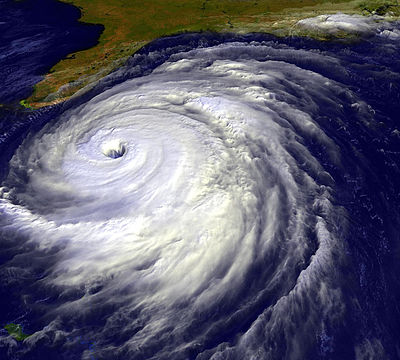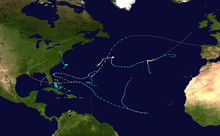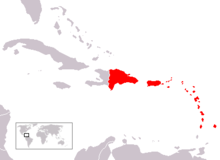Portal:Tropical cyclones
The Tropical Cyclones Portal

A tropical cyclone is a storm system characterized by a large low-pressure center, a closed low-level circulation and a spiral arrangement of numerous thunderstorms that produce strong winds and heavy rainfall. Tropical cyclones feed on the heat released when moist air rises, resulting in condensation of water vapor contained in the moist air. They are fueled by a different heat mechanism than other cyclonic windstorms such as Nor'easters, European windstorms and polar lows, leading to their classification as "warm core" storm systems. Most tropical cyclones originate in the doldrums, approximately ten degrees from the Equator.
The term "tropical" refers to both the geographic origin of these systems, which form almost exclusively in tropical regions of the globe, as well as to their formation in maritime tropical air masses. The term "cyclone" refers to such storms' cyclonic nature, with anticlockwise rotation in the Northern Hemisphere and clockwise rotation in the Southern Hemisphere. Depending on its location and intensity, a tropical cyclone may be referred to by names such as "hurricane", "typhoon", "tropical storm", "cyclonic storm", "tropical depression" or simply "cyclone".
Types of cyclone: 1. A "Typhoon" is a tropical cyclone located in the North-west Pacific Ocean which has the most cyclonic activity and storms occur year-round. 2. A "Hurricane" is also a tropical cyclone located at the North Atlantic Ocean or North-east Pacific Ocean which have an average storm activity and storms typically form between May 15 and November 30. 3. A "Cyclone" is a tropical cyclone that occurs in the South Pacific and Indian Oceans.
Selected named cyclone -
Hurricane Kenna was the fourth-most intense tropical cyclone on record in the Eastern Pacific basin, and at the time the third-most intense Pacific hurricane to strike the west coast of Mexico. Kenna was the sixteenth tropical depression, thirteenth tropical storm, seventh hurricane, sixth major hurricane, and third Category 5 hurricane of the 2002 Pacific hurricane season. After forming on October 22 to the south of Mexico from a tropical wave, forecasters consistently predicted the storm to strengthen much less than it actually did. Moving into an area of favorable upper-level conditions and warm sea surface temperatures, Kenna quickly strengthened to reach peak winds of 165 mph (270 km/h) as a Category 5 hurricane, on October 25, while located about 255 mi (410 km) southwest of Puerto Vallarta, Jalisco. Weakening as it turned to the northeast, the hurricane made landfall near San Blas, Nayarit as a Category 4 hurricane, with sustained winds of 140 mph (220 km/h), before dissipating on October 26 over the Sierra Madre Occidental mountains.
The name "Kenna" was retired from the list of Pacific hurricane names due to its effects on Mexico, which included US$101 million in damage and four deaths. The worst of the hurricane's effects occurred between San Blas in Nayarit and Puerto Vallarta in Jalisco, where over 100 people were injured and thousands of homes and businesses were damaged or destroyed. 95% of the buildings in San Blas were damaged, and hundreds of buildings were destroyed along coastal areas of Puerto Vallarta. (Full article...)Selected article -
The Great Hurricane of 1780 was the deadliest Atlantic hurricane on record, as well as the deadliest tropical cyclone in the Western Hemisphere. An estimated 22,000 people died throughout the Lesser Antilles when the storm passed through the islands from October 10 to October 16. Specifics on the hurricane's track and strength are unknown, as the official Atlantic hurricane database only goes back to 1851.
The hurricane struck Barbados likely as a Category 5 hurricane, with at least one estimate of wind gusts as high as 200 mph (320 km/h), before moving past Martinique, Saint Lucia, and Sint Eustatius, and causing thousands of deaths on those islands. Coming in the midst of the American Revolution, the storm caused heavy losses to the British fleet contesting for control of the area, largely weakening British control over the Atlantic. The hurricane later passed near Puerto Rico and over the eastern portion of Hispaniola, causing heavy damage near the coastlines. It ultimately turned to the northeast and was last observed on October 20 southeast of Atlantic Canada. (Full article...)Selected image -

Selected season -

The 1988 Pacific hurricane season was the least active Pacific hurricane season since 1981. It officially began May 15, in the eastern Pacific, and June 1, in the central Pacific and lasted until November 30. These dates conventionally delimit the period of each year when most tropical cyclones form in the northeastern Pacific Ocean. The first named storm, Tropical Storm Aletta, formed on June 16, and the last-named storm, Tropical Storm Miriam, was previously named Hurricane Joan in the Atlantic Ocean before crossing Central America and re-emerging in the eastern Pacific; Miriam continued westward and dissipated on November 2.
The season produced 23 tropical depressions, of which 15 attained tropical storm status. Seven storms reached hurricane status, three of which became major hurricanes. The strongest storm of the season, Hurricane Hector, formed on July 30 to the south of Mexico and reached peak winds of 145 mph (233 km/h)—Category 4 status—before dissipating over open waters on August 9; Hector was never a threat to land. Tropical Storm Gilma was the only cyclone in the season to make landfall, crossing the Hawaiian Islands, although there were numerous near-misses. Gilma's Hawaiian landfall was unusual, but not unprecedented. There were also two systems that successfully crossed over from the Atlantic: the aforementioned Joan / Miriam and Hurricane Debby, which became Tropical Depression Seventeen-E, making the 1988 season the first on record in which more than one tropical cyclone has crossed between the Atlantic and Pacific basins intact. Three systems caused deaths: Tropical Storm Aletta caused one death in southwestern Mexico, Hurricane Uleki caused two drownings off the coast of Oahu as it passed by the Hawaiian Islands, and Hurricane Kristy caused 21 deaths in the Mexican states of Oaxaca and Chipas. (Full article...)Related portals
Currently active tropical cyclones

Italicized basins are unofficial.
- North Atlantic (2024)
- No active systems
- East and Central Pacific (2024)
- No active systems
- West Pacific (2024)
- No active systems
- North Indian Ocean (2024)
- No active systems
- Mediterranean (2023–24)
- No active systems
- Australian region (2023–24)
- No active systems
- South Pacific (2023–24)
- No active systems
- South Atlantic (2023–24)
- No active systems
Last updated: 02:33, 2 May 2024 (UTC)
Tropical cyclone anniversaries

May 7
- 1932 - A tropical storm moved across Hispaniola.
- 2011 - Tropical Storm Aere (pictured) affects the Philippines killing 48 people and Php1.4 billion (US$34 million) in damages.

May 8
- 2003 - Cyclone Manou reached its peak intensity in the Indian Ocean with a central pressure of 967 hPa (mbar). Manou killed 70 people in Madagascar.
- 2017 - Cyclone Donna (pictured) attained peak intensity in the South Pacific Ocean, with peak 10 minute winds of 205 km/h (125 mph); this made it the strongest ever recorded Southern Hemisphere tropical cyclone in the month of May.

May 9
- 1961 - A cyclone struck what is now Bangladesh, killing 11,468 people.
- 1968 - A cyclone struck Myanmar, killing 1,049 people.
- 1990 - A powerful tropical cyclone (pictured) struck Andhra Pradesh in southeastern India. The cyclone killed a total of 967 people and damaged about US$600 million.
Did you know…




- …that the Joint Typhoon Warning Center considers that Typhoon Vera (pictured) of 1986 is actually two distinct systems, formed from two separated low-level circulations?
- …that Hurricane Agatha (pictured) was the strongest Pacific hurricane to make landfall in Mexico in May since records began in 1949?
- …that Cyclone Raquel (track pictured) travelled between the Australian and South Pacific basins between the 2014–15 and 2015–16 seasons, spanning both seasons in both basins?
- …that Cyclone Amphan (pictured) in 2020 was the first storm to be classified as a Super Cyclonic Storm in the Bay of Bengal since 1999?
General images -

The 1992 Atlantic hurricane season was among the least active of any Atlantic hurricane season on record. It produced six named tropical cyclones. The season officially started on June 1, 1992, and ended on November 30. These dates, adopted by convention, historically delimit the period each year when most Atlantic tropical systems form. However, storm formation is possible at any time of the year, as was the case this season, when Subtropical Storm One formed on April 21. This timeline documents all the storm formations, strengthening, weakening, landfalls, extratropical transitions, as well as dissipations during the season.
During the year, three tropical depressions, one subtropical storm, two tropical storms, and four hurricanes formed. It produced seven storms, less than the average of ten usually formed throughout an Atlantic hurricane season, while four of the storms went on to become hurricanes. The first cyclone to form inside the official season was Tropical Depression One, which formed on June 25. Of the four hurricanes, Hurricane Andrew was the most intense, reaching Category 5 status. In late June, Tropical Depression One caused severe flooding in southwestern Florida and Cuba; heavy rainfall was recorded in Pinar del Río, Matanzas, and Havana. When Andrew struck Florida and Louisiana in August, it became the second-costliest hurricane to hit the United States. Damages were estimated to be about $26.5 billion and 68 people were killed. Tropical Storm Danielle made landfall at the Delmarva Peninsula on the Virginian coast on September 25, causing minimal flooding. There was one recorded death recorded due to Danielle; a ship east of New Jersey was sunk due to rough seas. The season finished on October 30 when Hurricane Frances became an extratropical gale before dissipating. (Full article...)Topics
Subcategories
Related WikiProjects
WikiProject Tropical cyclones is the central point of coordination for Wikipedia's coverage of tropical cyclones. Feel free to help!
WikiProject Weather is the main center point of coordination for Wikipedia's coverage of meteorology in general, and the parent project of WikiProject Tropical cyclones. Three other branches of WikiProject Weather in particular share significant overlaps with WikiProject Tropical cyclones:
- The Non-tropical storms task force coordinates most of Wikipedia's coverage on extratropical cyclones, which tropical cyclones often transition into near the end of their lifespan.
- The Floods task force takes on the scope of flooding events all over the world, with rainfall from tropical cyclones a significant factor in many of them.
- WikiProject Severe weather documents the effects of extreme weather such as tornadoes, which landfalling tropical cyclones can produce.
Things you can do
 |
Here are some tasks awaiting attention:
|
Wikimedia
The following Wikimedia Foundation sister projects provide more on this subject:
-
Commons
Free media repository -
Wikibooks
Free textbooks and manuals -
Wikidata
Free knowledge base -
Wikinews
Free-content news -
Wikiquote
Collection of quotations -
Wikisource
Free-content library -
Wikiversity
Free learning tools -
Wikivoyage
Free travel guide -
Wiktionary
Dictionary and thesaurus
























































